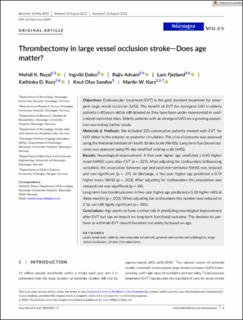| dc.contributor.author | Rezai Kallaj, Mehdi | |
| dc.contributor.author | Dalen, Ingvild | |
| dc.contributor.author | Advani, Rajiv | |
| dc.contributor.author | Fjetland, Lars | |
| dc.contributor.author | Kurz, Kathinka Dæhli | |
| dc.contributor.author | Sandve, Knut Olav Lende | |
| dc.contributor.author | Kurz, Friedrich Martin Wilhelm | |
| dc.date.accessioned | 2022-09-28T12:46:48Z | |
| dc.date.available | 2022-09-28T12:46:48Z | |
| dc.date.created | 2022-09-26T16:45:54Z | |
| dc.date.issued | 2022 | |
| dc.identifier.issn | 0001-6314 | |
| dc.identifier.uri | https://hdl.handle.net/11250/3022292 | |
| dc.description.abstract | Objectives
Endovascular treatment (EVT) is the gold standard treatment for emergent large vessel occlusion (LVO). The benefit of EVT for emergent LVO in elderly patients (>80 years old) is still debated as they have been under-represented in randomized controlled trials. Elderly patients with an emergent LVO are a growing population warranting further study.
Materials & Methods
We included 225 consecutive patients treated with EVT for LVO either in the anterior or posterior circulation. The clinical outcome was assessed using the National Institute of Health Stroke Scale (NIHSS). Long-term functional outcome was assessed using 90-day modified ranking scale (mRS).
Results
Neurological improvement: A five-year higher age predicted a 0.43 higher mean NIHSS score after EVT (p = .027). After adjusting for confounders (influencing variables), the association between age and post-interventional NIHSS was reduced and non-significant (p = .17). At discharge, a five-year higher age predicted a 0.74 higher mean NIHSS (p = .003). After adjusting for confounders this association was reduced and non-significant (p = .06).
Long-term functional outcome: A five-year higher age predicted a 0.20 higher mRS at three months (p < .001). When adjusting for confounders this number was reduced to 0.16, yet still highly significant (p < .001).
Conclusions
Age seems to have a minor role in predicting neurological improvement after EVT but has an impact on long-term functional outcome. The decision to perform or withhold EVT should therefore not solely be based on age. | en_US |
| dc.language.iso | eng | en_US |
| dc.publisher | Wiley | en_US |
| dc.rights | Navngivelse-Ikkekommersiell 4.0 Internasjonal | * |
| dc.rights.uri | http://creativecommons.org/licenses/by-nc/4.0/deed.no | * |
| dc.title | Thrombectomy in large vessel occlusion stroke—Does age matter? | en_US |
| dc.type | Journal article | en_US |
| dc.type | Peer reviewed | en_US |
| dc.description.version | publishedVersion | en_US |
| dc.rights.holder | Copyright 2022 The Author(s) | en_US |
| cristin.ispublished | true | |
| cristin.fulltext | original | |
| cristin.qualitycode | 1 | |
| dc.identifier.doi | 10.1111/ane.13691 | |
| dc.identifier.cristin | 2055631 | |
| dc.source.journal | Acta Neurologica Scandinavica | en_US |
| dc.identifier.citation | Acta Neurologica Scandinavica. 2022. | en_US |

